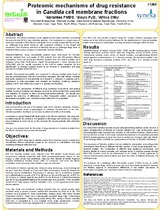| dc.contributor.author | Abrantes, Pedro Miguel dos Santos | |
| dc.contributor.author | Bouic, Patrick J.D. | |
| dc.contributor.author | Africa, Charlene W.J. | |
| dc.date.accessioned | 2014-08-14T07:54:48Z | |
| dc.date.available | 2014-08-14T07:54:48Z | |
| dc.date.issued | 2014 | |
| dc.identifier.citation | Abrantes, P.M.D.S. et al. (2014). Proteomic mechanisms of drug resistance in Candida cell membrane fractions. Journal of Dental Research, 93 (special issue B): 169;1264 | en_US |
| dc.identifier.uri | http://hdl.handle.net/10566/1179 | |
| dc.identifier.uri | http://www.iadr.org/i4a/pages/index.cfm?pageid=4212#.U-xqZWNCj6A | |
| dc.description | Poster presented at the International Association for Dental Research, 92nd General Session, Cape Town, South Africa, 25-28 June 2014. | |
| dc.description.abstract | INTRODUCTION: The African continent has the highest burden of HIV infection, accounting for approximately 65% of new infections globally. Oral candidiasis is a major cause of increased morbidity in HIV-infected individuals and is usually treated with fluconazole, an antifungal drug which interferes with ergosterol synthesis in the fungal cell membrane. The increased resistance of Candida species to antifungal drugs leads to treatment failure and an increase in untreatable Candida infections.
OBJECTIVES/METHODS: Drug susceptibility patterns were determined for Candida species isolated from oral swabs of 254 patients from two HIV-positive African populations. Forty cell membrane fractions isolated from the clinical isolates were analyzed using High Performance Liquid Chromatography – Mass Spectrometry (HPLC-MS) and the results compared to the UniProt protein database for the identification of Candida peptides known to be involved in colonization and drug resistance strategies within the host.
RESULTS: Fluconazole-susceptible and –resistant C. albicans isolates were found to express oxidoreductases that bind mammalian estrogens with high affinity. Peptides that confer resistance to formaldehyde were found in C. albicans, C. glabrata and C. dubliniensis in both susceptible and resistant cell fractions. Multidrug resistance proteins (CDR1 and CDR2) were seen in C. albicans cell fractions.
CONCLUSION: The combination of different drug resistance mechanisms and binding abilities to salivary histatins and estrogen seem to be instrumental in the colonisation and retention of Candida in these immunocompromised patients. The results also suggest the presence of differences in efflux transporter protein expression in fluconazole-susceptible and –resistant isolates within the HIV population. | en_US |
| dc.description.sponsorship | National Research Foundation of South Africa (NRF) | en_US |
| dc.language.iso | en | en_US |
| dc.publisher | International Association for Dental Research | en_US |
| dc.rights | This file may be freely used for educational uses, as long as it is not altered in any way. No commercial reproduction or distribution of this file is permitted without written permission of the authors. | |
| dc.subject | Candida | en_US |
| dc.subject | HIV infection | en_US |
| dc.subject | proteins | en_US |
| dc.title | Proteomic mechanisms of drug resistance in Candida cell membrane fractions | en_US |
| dc.type | Poster | en_US |
| dc.privacy.showsubmitter | false | |
| dc.status.ispeerreviewed | true | |

